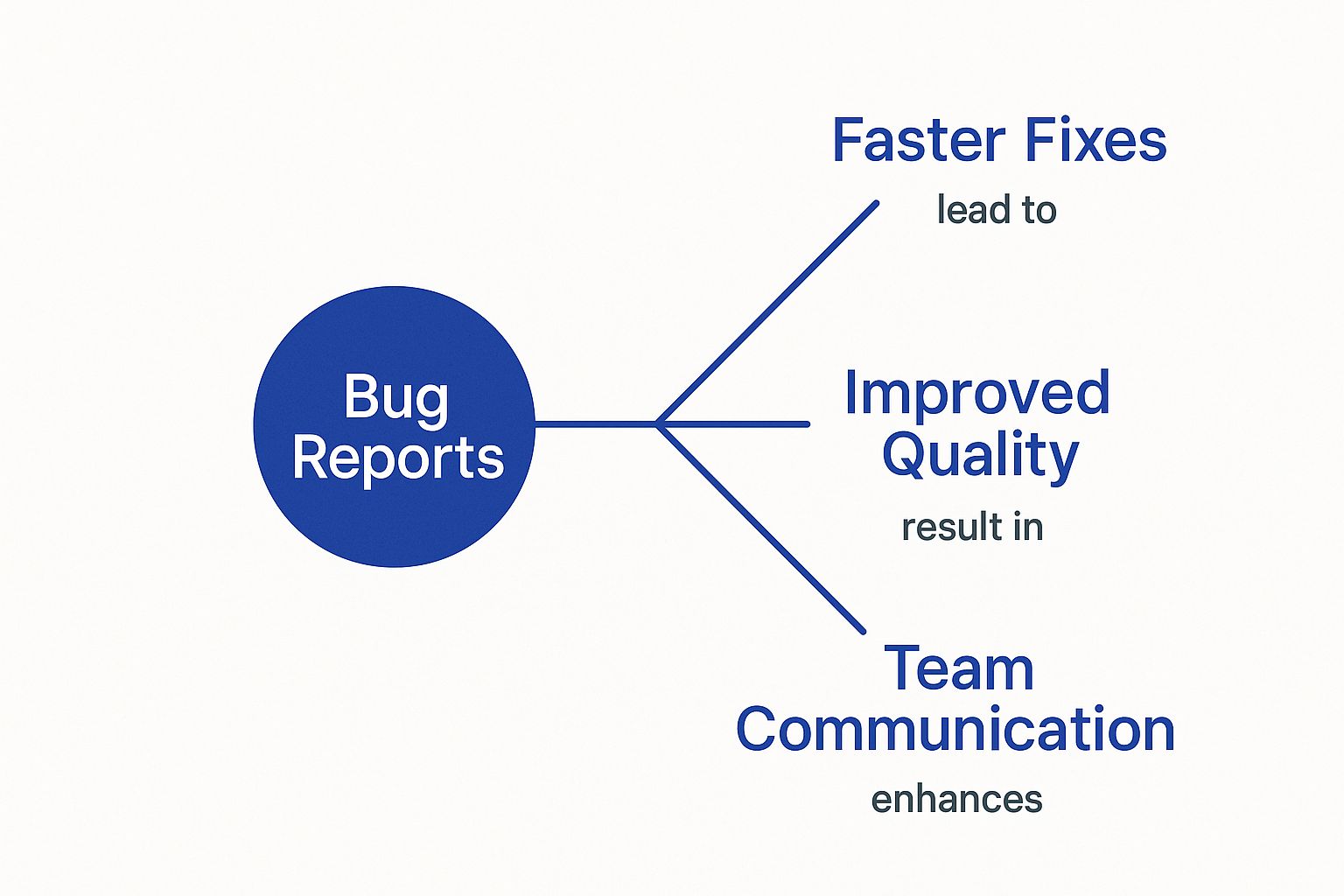Understanding Bug Reports: Your Software's Health Records

Imagine walking into a car repair shop and telling the mechanic, "It's broken." Where do they even begin? Without specifics, they're left playing a guessing game. Software development faces a similar challenge. Vague complaints about software issues waste everyone's time and create unnecessary frustration. This is where the power of bug reports comes into play.
So, what exactly are bug reports? Think of them as detailed medical records for your software. They document everything that's ailing your application, providing the precise information developers need to diagnose and fix the problems.
Bug reports act as a critical communication bridge between the people who discover the issues and the people who solve them. A well-crafted report equips developers with the knowledge they need to understand, reproduce, and ultimately resolve the bug. These reports tell a story, guiding the developer step-by-step through the process that led to the problem.
This focus on clarity and detailed information transforms bug reports from dry technical documents into powerful tools for collaboration. For example, a bug report might describe how a specific button on a website refuses to work in a particular browser. This level of detail allows the developer to zero in on the root cause quickly and efficiently.
The Importance of Bug Tracking Systems
The growing complexity of modern software and the increasing demand for high-quality applications have led to a greater reliance on bug tracking systems. These systems help teams manage and prioritize bugs effectively. Explore the growing bug tracking system market. The global market for these systems is expected to grow significantly between 2025 and 2033, experiencing a notable CAGR.
This investment in better bug management translates directly into several key benefits:
- Faster Fixes: Clear reports lead to quicker identification and resolution of issues.
- Improved Software Quality: Consistent bug reporting and tracking contribute to a more stable and reliable end product.
- Happier Users: By addressing bugs promptly and efficiently, you create a better user experience, leading to greater satisfaction.
By focusing on creating clear, actionable bug reports, development teams build a proactive approach to quality assurance. This, in turn, ensures a smoother development process and a more robust final product.
The Anatomy of Bug Reports That Actually Get Fixed

The infographic above neatly sums up why well-crafted bug reports are so valuable. They lead to quicker fixes, better software quality, and smoother communication within the team. It's a chain reaction: a clear report gets the right people on the problem fast, resulting in a better product and a happier team.
Think of a bug report not just as a complaint, but as a vital tool that improves the entire software development lifecycle. It's a small document with a big impact.
So, what makes a bug report truly effective? Imagine it as a compelling detective story.
Writing a Captivating Title and Description
Every good detective story starts with a hook. For a bug report, that's the title. Something concise and informative like, "Login Button Unresponsive on Chrome Browser," instantly tells developers what's wrong.
Then, the description expands on the title, providing crucial context. It's like setting the scene for the investigation.
Reproducing the Issue: Clear Steps to Follow
Next comes the recipe for recreating the bug: the steps to reproduce. Imagine trying to bake a cake without instructions! Developers need a precise, step-by-step guide to experience the bug themselves and diagnose the root cause.
These steps should be numbered and easy to follow, like a clear set of instructions. Include specifics like browser versions, operating systems (like Windows or macOS), and any unusual actions the user took.
Providing Evidence: Screenshots and Other Supporting Information
Visual evidence is invaluable. A screenshot or short video can be incredibly powerful – a picture is often worth a thousand words, especially with tricky visual glitches. This section might also include console logs or other technical information. Think of it as presenting the evidence gathered at the "crime scene." This gives developers the clues they need to act quickly.
And finally, the environment. This tells developers the specific context of the bug: the browser, operating system, and device used. It's like knowing the location and time of the incident in our detective story. It adds another layer of detail, ensuring the developers have the complete picture.
Let's look at some examples to illustrate how to write effective bug report components. The table below compares good and poor examples, highlighting why each component matters.
| Component | Poor Example | Good Example | Why It Matters |
|---|---|---|---|
| Title | "Something's broken" | "Login Button Unresponsive on Chrome Browser" | A clear, concise title allows developers to quickly understand the issue at a glance. It also helps with searching and filtering bug reports. |
| Description | "The login button doesn't work." | "After entering valid credentials and clicking the login button on Chrome Version 104, the button becomes unresponsive and the user is not logged in. This issue does not occur on Firefox or Safari." | A detailed description provides essential context and clarifies the problem's scope. It avoids ambiguity and saves developers time in investigation. |
| Steps to Reproduce | "Click the login button." | 1. Open Chrome browser (Version 104). 2. Navigate to website URL. 3. Enter valid username "testuser" and password "password123". 4. Click the login button. |
Clear, numbered steps allow anyone to replicate the bug consistently, which is essential for diagnosis and fixing. |
| Screenshots/Videos | (None) | Visual evidence clearly demonstrates the issue, especially for visual bugs. It removes ambiguity and speeds up the debugging process. | |
| Environment | (Not specified) | Browser: Chrome Version 104 Operating System: macOS Ventura Device: MacBook Pro 16-inch |
Specifying the environment helps developers isolate the problem and understand its potential causes. It helps determine if the bug is platform-specific. |
The table above demonstrates how a little extra effort in crafting each component of a bug report can make a huge difference in its effectiveness. A good bug report is like a well-prepared case file for a detective: it provides all the necessary information for a swift resolution.
How Smart Bug Reporting Accelerates Development Cycles

Think of a well-oiled machine. Every gear turns smoothly, driving the entire mechanism forward with precision and speed. High-quality bug reports are like those finely tuned gears in the complex machine of software development. They’re not just documentation; they’re catalysts for efficiency.
When bug reports are well-crafted, the entire development process flows seamlessly. This is especially true in Agile and DevOps environments, which rely on rapid iteration and continuous feedback. A solid bug report is essential here.
Imagine a fast-paced sprint. A good bug report empowers developers to address issues quickly, keeping the project on track and preventing momentum-killing roadblocks. It seamlessly integrates into the continuous integration and continuous delivery (CI/CD) pipelines central to DevOps, ensuring quality throughout the development lifecycle.
Effective bug reporting can also transform potential friction between QA and development teams into collaborative opportunities. Think of it like a game of catch. A clear, concise bug report is like a well-thrown ball, easy to catch and handle. This allows developers to tackle the bug efficiently, boosting team morale and reducing frustration.
Beyond individual fixes, bug reports serve as a form of institutional memory. They provide a valuable history of encountered issues, allowing teams to identify recurring problems and potential underlying weaknesses in the architecture. This historical data is like a roadmap, guiding future development decisions towards more robust and stable software.
Well-crafted bug reports also establish a crucial feedback loop. This loop continually improves overall product quality and team communication, driving a cycle of continuous improvement. This, in turn, leads to greater team confidence in releases and ultimately, a more polished final product.
This is where dedicated bug tracking systems like Jira excel. They facilitate this continuous improvement cycle, reducing development time and bolstering the final product's quality. Studies have shown that companies using advanced bug tracking platforms can reduce bug resolution time by up to 30%. Discover more insights into bug tracking platforms.
Real Bug Reports That Changed Everything
Let's talk about the impact of a well-written bug report. It's like detective work, where seemingly small details can crack the case. Here are some real-world examples that show how crucial these reports can be.
The Case of the Vanishing Cart
Picture this: a busy e-commerce site during a huge sale. Suddenly, customers report items disappearing from their carts. Panic! Initial reports were vague – "Cart not working," "Losing items" – leaving developers scratching their heads.
But then, a detailed bug report arrived. It meticulously listed the steps to reproduce the problem:
- Add specific items to the cart.
- Browse a particular product category.
- Return to the cart.
Critically, it also included the user’s browser and operating system. This was the clue that cracked the case. Developers discovered a conflict between the site’s JavaScript and a specific browser version. A quick fix saved the company thousands in potential lost sales. That one report was a game-changer.
The Great Login Mystery
User logins are the gateway to sensitive data. A bug here can be a real nightmare. Imagine users being randomly locked out of their accounts. Early reports just said, "Can't log in." Not very helpful.
Then came a report with a key detail: the issue only affected users with passwords containing special characters. Bingo! This led developers straight to a flaw in the password validation code. A targeted fix, all thanks to one insightful report.
Data Corruption Catastrophe Averted
Data integrity is everything, especially for systems handling critical information. Imagine a database holding vital financial records. A bug causing data corruption? Disaster.
A generic report like, "Data seems wrong," raises the alarm but doesn't point to the problem. One well-written report, however, turned the tide. It included a specific database query that consistently produced corrupted data. This isolated the problem, allowing developers to fix the faulty code and prevent a potential data meltdown.
This photo shows the first actual computer "bug" – a moth stuck in a relay of the Harvard Mark II computer back in 1947. Funny, right? But it illustrates a point: even small glitches can cause big problems in complex systems.
This "first bug" highlights the power of documentation. What if the team had just removed the moth without recording it? The problem could have easily returned. Documenting the bug paved the way for better debugging processes.
These stories show how essential precise, detailed bug reports are. They’re not just paperwork; they’re the cornerstone of efficient debugging and a smoother user experience. They enable faster fixes, prevent costly delays, and separate good QA from the rest. They are the key to building better software.
Writing Bug Reports That Developers Thank You For
Let's face it, nobody likes finding bugs. But when you do, the way you communicate them can make all the difference. Building a good relationship with your development team hinges on this. It's not just about reporting the bug; it's about making sure the report is actually helpful. Think of it like giving someone directions. Clear, concise instructions get them there quickly. A rambling, vague description? Not so much. A well-written bug report gets the developers to the "fix" faster.
Understanding the Developer's Perspective
Imagine being a developer, swimming in a sea of bug reports. Some are good, some… not so much. A report that just says "It's broken!" is like telling a mechanic "The car makes a funny noise." Where do they even begin? They have to become detectives, spending precious time trying to understand the problem instead of fixing it. That's why putting yourself in the developer's shoes is so important when writing a report.
Strategies for Effective Communication
Communicating urgency is crucial, but there’s a fine line between highlighting a problem and sounding the alarm bells unnecessarily. Instead of emotionally charged language, focus on the impact. Explain how the bug affects users or disrupts important business processes. Timing is everything too. Dropping a bug report right before a major release? Probably not the best idea. If possible, report bugs during less hectic periods. Follow up is good, but remember the story of the boy who cried wolf. A gentle nudge is fine; constant nagging, not so much.
Optimizing Your Reports for Action
A picture is worth a thousand words, right? Screenshots and recordings are invaluable. They provide instant visual context. Try describing a complicated visual glitch without a picture – you’ll quickly understand their importance. Technical information is also key, but avoid information overload. Include essential details like browser version and operating system, but skip the unnecessary jargon. Finally, be precise and descriptive in your writing. Paint a clear picture of the problem, so developers can easily understand and reproduce it.
You might be interested in: Learn more about writing better documentation and bug reports. By mastering these communication strategies and using best practices, your bug reports will become valuable tools, fostering collaboration and speeding up development. You'll turn bug reporting from a potential point of friction into a chance to build stronger relationships and deliver better software.
Bug Reports as Security Early Warning Systems

Imagine a seemingly small crack in a dam. While it might not seem like much at first, it could signal a much larger, underlying structural weakness. Similarly, what might appear to be a minor software bug can sometimes hint at a significant security vulnerability. A bug report, in this sense, acts like a canary in a coal mine, alerting us to potential dangers lurking beneath the surface.
This is where skilled QA professionals truly shine. They're trained to spot the subtle clues that a bug report might be more than just a routine fix, potentially uncovering a serious security flaw.
Recognizing Potential Security Implications
So, how can you distinguish a simple bug from a potential security risk? There are certain red flags that should immediately grab your attention.
For instance, imagine a bug that allows unauthorized access to sensitive user data. This is a clear sign of a potential security breach. Similarly, any bug that allows manipulation of critical information should be treated with extreme caution.
Bugs related to authentication, authorization, or input validation are also particularly concerning. These are common entry points for attackers, making them prime targets for exploitation. Think of them as the weak points in a castle wall – the places where attackers are most likely to try and breach your defenses. You might be interested in: Check out our complete guide on website quality assurance testing.
Responsible Disclosure and Bug Bounty Programs
When a potential security vulnerability is discovered, responsible disclosure is crucial. This means privately informing the organization about the issue, giving them a chance to fix it before going public. This approach protects users and prevents widespread exploitation of the vulnerability. Think of it as giving the dam's engineers time to repair the crack before it bursts.
The emergence of bug bounty programs has further incentivized responsible reporting. These programs offer rewards to security researchers who identify and report vulnerabilities, creating a win-win situation for both companies and users.
This careful balance of transparency and discretion is paramount in the world of cybersecurity. The interconnected nature of modern software systems has magnified the impact of security breaches, making robust bug reporting processes and vigilant QA teams more critical than ever. The demand for effective bug tracking systems has surged in response to this escalating cyber threat. With cybercrime costs projected to reach a staggering $10.5 trillion by 2025, software reliability and security are no longer optional—they're essential. Discover more cybersecurity statistics.
Creating a Bug Reporting Culture That Thrives
Building a thriving bug reporting culture isn't about rigid processes; it's about cultivating the right environment. Think of it like tending a garden. You need fertile soil (your processes), but also sunshine (encouragement) and water (consistent feedback). Successful teams know this and encourage everyone, from developers to customer support, to report bugs openly, without fear of blame. This transforms bug reports from dreaded chores into valuable contributions.
Imagine two teams. In one, finding a bug feels like criticizing someone's work. People hesitate to report issues, problems fester, and resentment brews. In the other team, reporting a bug is seen as helping the team, improving the product, and ultimately, benefiting the user. It becomes a shared responsibility, a collaborative effort to make things better.
Fostering Positive Reinforcement and Feedback
Just like a good coach celebrates winning plays and offers guidance on weaker ones, acknowledging helpful bug reports is crucial. A simple "thank you" can go a long way. Even more effective is public recognition in team meetings. And don't forget constructive feedback on less effective reports – this creates a feedback loop that constantly improves the quality of reports over time. For more tips, check out our article on quality assurance best practices.
Measuring the Health of Your Bug Reporting Culture
How do you know if your efforts are bearing fruit? Just like a gardener monitors plant growth, you need to track key metrics. The number of bugs reported, the time it takes to resolve them, and the overall quality of the reports offer valuable insights. They tell you what’s working and where you need to focus your attention. Effective training, regular feedback, and recognition systems are all key to a sustainable bug reporting culture.
Before we dive into actionable steps, let's assess your current bug reporting culture. The table below provides a framework for evaluating and improving your team's approach.
Bug Reporting Culture Assessment
Self-assessment checklist to evaluate and improve your team’s bug reporting culture
| Culture Aspect | Current State | Target State | Action Items |
|---|---|---|---|
| Open Communication | Bugs are sometimes reported hesitantly. | Team members proactively report bugs without fear of blame. | Implement anonymous reporting options. Hold regular workshops on constructive feedback. |
| Feedback & Recognition | Occasional feedback provided on bug reports. | Consistent feedback and recognition for valuable reports. | Establish a clear process for acknowledging and rewarding helpful bug reports. |
| Process Efficiency | Bug reporting process can be slow and cumbersome. | Streamlined bug reporting process with clear guidelines. | Implement a bug tracking tool like Jira or Bugzilla. Create standardized bug report templates. |
| Training & Education | Limited training on effective bug reporting. | Regular training and resources available on bug reporting best practices. | Offer workshops on writing effective bug reports. Create internal documentation with examples. |
This self-assessment highlights areas where your team excels and where improvements are needed. Use the action items as a roadmap for creating a more effective bug reporting process.
Turning bug reporting from a chore into a competitive advantage is a game-changer. It empowers your team to build better products and deliver exceptional user experiences. Ready to transform your feedback process? Start smashing bugs with BugSmash!




